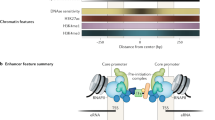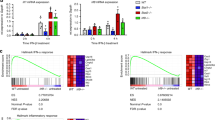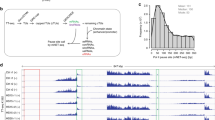Abstract
Genetic analysis of eukaryotic transcriptional promoters has revealed that protein-coding genes often contain a complex array of cis-control elements consisting of upstream activator sequences and enhancer elements1–5. The metallothionein genes provide a useful example for dissecting the action of multiple interspersed control elements that govern both basal level and regulated expression in animal cells6–8. The human metallothionein (hMTIIA) promoter has been analysed in detail and found to contain no less than five distinct control elements in the 5' flanking regions of the gene that mediate specificity and regulation of transcription9,10 (Fig. 1). These different control elements can be functionally subdivided into two categories: basal and induced elements. There are several distinct basal recognition sequences, which include a TATA-box, a GC-box, and at least two basal level enhancer (BLE) sequences, that function like classical enhancer elements10–12. The hMTIIA gene also responds to induction by heavy metals and by steroid hormones through the action of metal regulatory elements (MRE) and glucocorticoid responsive elements (GRE)9. Here we report the identification of two cellular DNA-binding proteins that interact selectively with sequences governing the basal level expression of hMTIIA. One of these factors is a novel activator protein (API) that interacts with sequences in the BLE of hMTIIA and also binds to a site within the 72-base pair (bp) repeats of the simian virus 40 (SV40) enhancer region. The second protein has been purified to homogeneity and shown to be transcription factor Sp1 which recognizes and binds to a single GC-box element within the hMTIIA promoter.
This is a preview of subscription content, access via your institution
Access options
Subscribe to this journal
Receive 51 print issues and online access
$199.00 per year
only $3.90 per issue
Buy this article
- Purchase on Springer Link
- Instant access to full article PDF
Prices may be subject to local taxes which are calculated during checkout
Similar content being viewed by others
References
Breathnach, R. & Chambon, P. A. A. Rev. Biochem. 50, 349–383 (1981).
Serfling, E., Vasin, M. & Schafiner, W. Trends Genet. 1, 224–230 (1985).
Fromm, M. & Berg, P. J. molec. appl. Genet. 1, 457–481 (1982).
Dynan, W. & Tjian, R. Nature 316, 774–778 (1985).
McKnight, S. & Tjian, R. Cell (in the press).
Heguy, A., West, A., Richards, R. I. & Karin, M. Molec. cell. Biol. 6, 2147–2157 (1986).
Schmitt, C. J. & Hamer, D. H. Proc. natn. Acad. Sci. U.S.A. 83, 3346–3350 (1986).
Karin, M. Cell 41, 9–10 (1985).
Karin, M. et al. Nature 308, 513–519 (1984).
Karin, M., Haslinger, A., Heguy, A., Deitlin, T. & Cooke, T. Molec. cell. biol. (submitted).
Haslinger, A. & Karin, M. Proc. natn. Acad. Sci. U.S.A. 82, 8572–8576 (1985).
Serfling, E., Lubbe, A., Dorach-Hasler, K. & Schaffner, W. EMBO J. 4, 3851–3859 (1985).
Dynan, W. S. & Tjian, R. Cell 32, 669–680 (1983).
Dynan, W. S. & Tjian, R. Cell 35, 79–87 (1983).
Kadonaga, J. T. & Tjian, R. Proc. natn. Acad. Sci. U.S.A. 83, 5889–5893 (1986).
Briggs, M. R., Kadonaga, J. T., Bell, S. P. & Tjian, R. Science 234, 47–52 (1986).
Banerji, J., Rusconi, S. & Schaffner, W. Cell 27, 299–308 (1981).
Weiher, H., Konig, M. & Grass, P. Science 219, 626–631 (1983).
Zenke, M. et al. EMBO J. (in the press).
Herr, W. & Gluzman, Y. Nature 313, 711–714 (1985).
Scholer, H., Haslinger, A., Heguy, A., Holtgreve, H. & Karin, M. Science 232, 176–180 (1986).
Dynan, W. S., Safier, J. D., Lee, W. S. & Tjian, R. Proc. natn. Acad. Sci. U.S.A. 82, 4915–4919 (1985).
Kadonaga, J. T., Jones, K. A. & Tjian, R. Trends Biochem. 11, 20 (1986).
Gidoni, D., Dynan, W. S. & Tjian, R. Nature 312, 409–413 (1984).
Gidoni, D. et al. Science 230, 511–517 (1985).
Jones, K. A., Yamamoto, K. R. & Tjian, R. Cell 42, 559–572 (1985).
Graves, B. J., Johnson, P. F. & McKnight, S. L. Cell 44, 565–576 (1986).
McKnight, S. L., Gavis, E. R., Kingsbury, R. & Axel, R. Cell 25, 385–398 (1981).
McKnight, S. L. & Kingsbury, R. C. Science 217, 316–324 (1982).
Jones, K. A. & Tjian, R. Nature 317, 179 (1985).
Author information
Authors and Affiliations
Rights and permissions
About this article
Cite this article
Lee, W., Haslinger, A., Karin, M. et al. Activation of transcription by two factors that bind promoter and enhancer sequences of the human metallothionein gene and SV40. Nature 325, 368–372 (1987). https://doi.org/10.1038/325368a0
Received:
Accepted:
Issue Date:
DOI: https://doi.org/10.1038/325368a0
This article is cited by
-
The Krüppel-like factor 9 cistrome in mouse hippocampal neurons reveals predominant transcriptional repression via proximal promoter binding
BMC Genomics (2017)
-
Deciphering fact from artifact when using reporter assays to investigate the roles of host factors on L1 retrotransposition
Mobile DNA (2016)
-
Differential regulation of the rainbow trout (Oncorhynchus mykiss) MT-A gene by nuclear factor interleukin-6 and activator protein-1
BMC Molecular Biology (2013)
-
Analysis of gene expression in apoptosis of human lymphoma U937 cells induced by heat shock and the effects of α-phenyl N-tert-butylnitrone (PBN) and its derivatives
Apoptosis (2005)
Comments
By submitting a comment you agree to abide by our Terms and Community Guidelines. If you find something abusive or that does not comply with our terms or guidelines please flag it as inappropriate.



